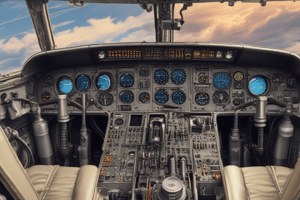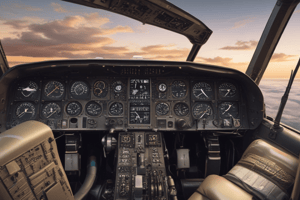Podcast
Questions and Answers
What is the purpose of aeroplane central maintenance computers?
What is the purpose of aeroplane central maintenance computers?
To describe the operation and function of aeroplane central maintenance computers (Level 2)
What are some key components of the Aeroplane Central Maintenance System?
What are some key components of the Aeroplane Central Maintenance System?
- Flight Warning Computers and ECAM Displays (correct)
- Multifunction Control Display Unit (correct)
- Aeroplane Central Maintenance Computers (correct)
- Data Loading System
The Data Loading System on Aeroplanes is used to monitor structural components.
The Data Loading System on Aeroplanes is used to monitor structural components.
False (B)
The Electronic Library System in aeroplanes is also known as Electronic _____ Bag.
The Electronic Library System in aeroplanes is also known as Electronic _____ Bag.
What do the knowledge level indicators 1, 2, and 3 represent in the context of aircraft maintenance licensing?
What do the knowledge level indicators 1, 2, and 3 represent in the context of aircraft maintenance licensing?
What is the objective of Level 2 knowledge in aircraft maintenance licensing?
What is the objective of Level 2 knowledge in aircraft maintenance licensing?
In aircraft maintenance licensing, Level 3 knowledge requires the applicant to know the theory of the subject and ______________ with other subjects.
In aircraft maintenance licensing, Level 3 knowledge requires the applicant to know the theory of the subject and ______________ with other subjects.
What is the purpose of the On-board Maintenance System (OMS)?
What is the purpose of the On-board Maintenance System (OMS)?
Which systems are part of the On-board Maintenance System (OMS)?
Which systems are part of the On-board Maintenance System (OMS)?
The Central Maintenance System operates in two modes: normal mode and menu mode.
The Central Maintenance System operates in two modes: normal mode and menu mode.
The Central Maintenance Computer (CMC) acquires and processes data received from the _____ memories of system computers.
The Central Maintenance Computer (CMC) acquires and processes data received from the _____ memories of system computers.
Match the following components with their descriptions:
Match the following components with their descriptions:
What is required to load and update software on aircraft computer systems?
What is required to load and update software on aircraft computer systems?
Which data loader types are linked with the Flight Management System (FMS) or connected to a data bus coupler?
Which data loader types are linked with the Flight Management System (FMS) or connected to a data bus coupler?
Portable Data Loaders are connected to the airplane with ARINC data buses for loading.
Portable Data Loaders are connected to the airplane with ARINC data buses for loading.
The Portable Maintenance Access Terminal (PMAT) supplies the airplane with ARINC data buses for __________.
The Portable Maintenance Access Terminal (PMAT) supplies the airplane with ARINC data buses for __________.
What type of display is the Display Unit (DU) in an aeroplane?
What type of display is the Display Unit (DU) in an aeroplane?
What type of data does the Display Unit (DU) show?
What type of data does the Display Unit (DU) show?
The Display Unit operates on 12-V DC power.
The Display Unit operates on 12-V DC power.
The printer in the aeroplane is designed to print reports from various systems like Flight Management System (FMS) and _____.
The printer in the aeroplane is designed to print reports from various systems like Flight Management System (FMS) and _____.
Match the following monitoring systems with their purpose:
Match the following monitoring systems with their purpose:
What does the Network Interface Controller (NIC) manage in the MAU?
What does the Network Interface Controller (NIC) manage in the MAU?
What does the BIC (Bus Interface Controller) frame buffer allow in the MAU?
What does the BIC (Bus Interface Controller) frame buffer allow in the MAU?
Client modules connected to the backplane bus communicate with NIC through BIC frame buffer.
Client modules connected to the backplane bus communicate with NIC through BIC frame buffer.
The Avionics Standard-Communication Bus (ASCB) is a high-speed serial data bus transmitting data in frames of ____ milliseconds.
The Avionics Standard-Communication Bus (ASCB) is a high-speed serial data bus transmitting data in frames of ____ milliseconds.
Match the following data buses/networks with their descriptions:
Match the following data buses/networks with their descriptions:
What are the functions of the Additional Attendant Panel (AAP)?
What are the functions of the Additional Attendant Panel (AAP)?
The Attendant Indication Panels (AIP) are controlled via an RS 232 data bus.
The Attendant Indication Panels (AIP) are controlled via an RS 232 data bus.
What does ACP stand for?
What does ACP stand for?
The Area Call Panel has four separately controlled fields, each containing colored ____.
The Area Call Panel has four separately controlled fields, each containing colored ____.
Match the communication links with their functions:
Match the communication links with their functions:
What happens when a bleed air leak is detected by the Overheat Detection Unit (OHDU)?
What happens when a bleed air leak is detected by the Overheat Detection Unit (OHDU)?
What is the purpose of the Cabin Intercommunication Data System (CIDS)?
What is the purpose of the Cabin Intercommunication Data System (CIDS)?
Match the following components with their functions in the Cabin Intercommunication Data System (CIDS):
Match the following components with their functions in the Cabin Intercommunication Data System (CIDS):
The CIDS Director (DIR) has two identical directors, with one in active mode and the other in standby mode.
The CIDS Director (DIR) has two identical directors, with one in active mode and the other in standby mode.
What type of feedback do the Linear Variable Differential Transformers (LVDTs) provide to the Primary Actuator Control Electronics (P-ACE) System?
What type of feedback do the Linear Variable Differential Transformers (LVDTs) provide to the Primary Actuator Control Electronics (P-ACE) System?
What technology is used for communication between Avionics Data Communication Network (ADCN) subscribers?
What technology is used for communication between Avionics Data Communication Network (ADCN) subscribers?
Match the avionics application with its dedicated Integrated Modular Avionics (IMA) on a B787:
Match the avionics application with its dedicated Integrated Modular Avionics (IMA) on a B787:
Each Integrated Modular Avionics (IMA) unit on an A380 is a metal cabinet grounded to the aircraft frame.
Each Integrated Modular Avionics (IMA) unit on an A380 is a metal cabinet grounded to the aircraft frame.
In the A380 IMA system, Core Processing Input/Output Modules (CPIOMs) dialogue through the Avionics Data Communication Network (ADCN) using ______ technology.
In the A380 IMA system, Core Processing Input/Output Modules (CPIOMs) dialogue through the Avionics Data Communication Network (ADCN) using ______ technology.
Flashcards
On-Board Maintenance System (OMS)
On-Board Maintenance System (OMS)
A system that assists maintenance personnel in identifying and resolving faults in complex avionics systems.
Central Maintenance System (CMS)
Central Maintenance System (CMS)
A key component of OMS that allows mechanics to access maintenance data and initiate tests on aircraft systems.
Normal Mode (CMS)
Normal Mode (CMS)
The normal operating mode of CMS where it records fault messages generated by Flight Warning Computers and failure information from BITE functions.
Menu Mode (CMS)
Menu Mode (CMS)
Signup and view all the flashcards
Central Maintenance Computer (CMC)
Central Maintenance Computer (CMC)
Signup and view all the flashcards
CMC Central Processing Unit (CPU)
CMC Central Processing Unit (CPU)
Signup and view all the flashcards
CMC Memory
CMC Memory
Signup and view all the flashcards
CMC Memory: Previous Flight Report (PFR)
CMC Memory: Previous Flight Report (PFR)
Signup and view all the flashcards
CMC Switching Control
CMC Switching Control
Signup and view all the flashcards
CMC Switching: Cockpit Pushbutton
CMC Switching: Cockpit Pushbutton
Signup and view all the flashcards
CMC BITE Failure
CMC BITE Failure
Signup and view all the flashcards
Flight Warning Computers
Flight Warning Computers
Signup and view all the flashcards
ECAM (Airbus)
ECAM (Airbus)
Signup and view all the flashcards
EICAS (Boeing)
EICAS (Boeing)
Signup and view all the flashcards
Aeroplane System Computers
Aeroplane System Computers
Signup and view all the flashcards
System Computers: Type 1
System Computers: Type 1
Signup and view all the flashcards
System Computers: Type 2
System Computers: Type 2
Signup and view all the flashcards
System Computers: Type 3
System Computers: Type 3
Signup and view all the flashcards
Multifunction Control Display Unit (MCDU)
Multifunction Control Display Unit (MCDU)
Signup and view all the flashcards
Aircraft Communications Addressing and Reporting System (ACARS)
Aircraft Communications Addressing and Reporting System (ACARS)
Signup and view all the flashcards
Data Loading System
Data Loading System
Signup and view all the flashcards
Electronic Library System
Electronic Library System
Signup and view all the flashcards
Electronic Flight Bag (EFB)
Electronic Flight Bag (EFB)
Signup and view all the flashcards
Display Unit (DU)
Display Unit (DU)
Signup and view all the flashcards
Aeroplane Printer
Aeroplane Printer
Signup and view all the flashcards
Aeroplane Condition Monitoring System (ACMS)
Aeroplane Condition Monitoring System (ACMS)
Signup and view all the flashcards
Strain Gauge
Strain Gauge
Signup and view all the flashcards
Piezo Sensor
Piezo Sensor
Signup and view all the flashcards
Integrated Modular Avionics (IMA)
Integrated Modular Avionics (IMA)
Signup and view all the flashcards
Modular Avionics Unit (MAU)
Modular Avionics Unit (MAU)
Signup and view all the flashcards
Network Interface Controller (NIC)
Network Interface Controller (NIC)
Signup and view all the flashcards
Study Notes
Category B1 Licence
- The Category B1 licence requires basic knowledge of turbine aeroplane aerodynamics, structures, and systems.
Knowledge Levels
- Knowledge levels for categories A, B1, and B2 are indicated by the allocation of knowledge level indicators (1, 2, or 3) against each applicable subject.
- Knowledge levels are defined as:
- Level 1: Familiarity with basic elements of the subject, ability to give a simple description, and use of typical terms.
- Level 2: General knowledge of theoretical and practical aspects of the subject, ability to apply knowledge, and use of mathematical formulae.
- Level 3: Detailed knowledge of theoretical and practical aspects of the subject, capacity to combine and apply separate elements of knowledge.
On-Board Maintenance Systems (11.18)
- On-Board Maintenance System (OMS) assists maintenance personnel in fault-finding of complex avionics systems.
- OMS uses various techniques built into and integrated with aircraft systems.
- OMS minimizes ground time, increases maintenance process efficiency, and improves cost-effectiveness.
- OMS consists of:
- Central Maintenance System (CMS)
- Data loading system
- Electronic library system
- Report printing system
Aeroplane Central Maintenance System
- Central Maintenance System (CMS) enables mechanics to extract maintenance data concerning most aircraft systems and initialize tests on these systems.
- CMS consists of:
- Central Maintenance Computers (CMC 1 and 2)
- Multipurpose Control and Display Units (MCDU 1, 2, and 3)
- CMC acquires and processes data received from BITE memories of system computers.
- MCDUs are used for control of interrelated systems and display of relevant output messages.
Modes of Central Maintenance System
- Normal Mode: CMS records fault messages generated by Flight Warning Computers (FWC) and failure information produced by BITE function integrated in computers.
- Menu Mode: CMS allows operators to obtain troubleshooting data from systems and initiate self-tests via MCDU (maintenance bite).
Central Maintenance Computer
- Central Maintenance Computer (CMC) systems provide a centralized location for aircraft fault information.
- CMC systems are used in conjunction with ECAM (Airbus) or EICAS (Boeing) cockpit display systems.
- CMC correlates messages with aircraft parameters to amalgamate faults with time, date, flight phase, etc.
CMC Data
- CMC incorporates memory for storage of maintenance data for retrieval.
- CMC Central Processing Unit (CPU) organizes received data into reports.### Central Maintenance Computers (CMCs)
- The CMC records failure information and messages received from the system BITE in a non-volatile memory system.
- The CMC compiles a Previous Flight Report (PFR) by storing all ECAM and failure messages recorded during the 63 previous flight legs.
- At each leg opening transition, the CMC:
- Files the current flight.
- Updates the 64 last legs filed in the previous flight report.
- Memorises the new leg heading: date, flight number, city pair from, start time, and A/C identification.
- At each leg closing transition, the CMC:
- Memorises the end time.
- Memorises the city pair to.
CMC Switching Control and Self-Test Function
- Typically, there are two CMCs available in large modern commercial aircraft for redundancy purposes.
- In normal operation, the CMC 1 is the master.
- CMC can be switched through:
- BITE fault.
- MCDU selection.
- Pushbutton switch in the cockpit overhead panel.
- If the off legend illuminates on the pushbutton, the CMC 2 is active and considered the master.
- CMC BITE failure will result in:
- A failure indication on the MCDU and printer.
- Failure details being sent to the main base via the Management Unit (MU) of the ACARS (optional system) or via the Air Traffic Service Unit (ATSU) (optional system).
Flight Warning Computers and ECAM Displays
- The flight warning computers monitor the operational data to display warnings and system information.
- The warnings will be displayed automatically with the relevant flight phase, and it displays until the end of the flight unless it has been cancelled.
- ECAM display shows system failures classified into three categories:
- Class 1: Failures which have an operational consequence for the current flight.
- Class 2: Failures which have no operational consequence for the current flight.
- Class 3: Failures which have neither operational nor safety consequences for the aircraft.
Aeroplane System Computers
- The various aircraft systems are linked to the CMC with different hardware interfaces and different BITE characteristics.
- System computers are categorised into three different types depending on their memory and connection to the central maintenance computers:
- Type 1: Connected to both CMCs by an ARINC 429 output bus and to the CMC 1 by an ARINC 429 input bus.
- Type 2: Memorise only failures from the last flight.
- Type 3: Cannot memorise failure messages.
Multifunction Control Display Unit (MCDU)
- The MCDU consists of a screen for data display, an alphanumeric keyboard, and line keys used to send commands to the connected systems.
- The MCDU provides access to data from the CMC system and allows testing of aircraft systems.
- Examples of testing include self-tests used in conjunction with the AMM for LRU removal/installation checks and guided tests used for system fault-finding.
Aircraft Communications Addressing and Reporting System (ACARS)
- The CMC can integrate with the ACARS, Satellite Communication (SATCOM), wireless LAN, and other communication systems.
- These communication systems send maintenance information from the aircraft in advance of its arrival at the destination station.
Data Loading System on Aeroplanes
- A software loader or data loader is required to load and update software.
- Data loaders are linked with the Flight Management System (FMS) or connected to a data bus coupler.
- Data loaders can be:
- Portable: Taken to the aircraft and plugged in.
- Integrated into the avionics system.
Electronic Library Systems in Aeroplanes
- The electronic library system replaces most of the normal cockpit paperwork with a computer-based reference system.
- The system includes:
- Aircraft operations manuals.
- Maintenance information.
- Checklists.
- Cabin management tools.
- Systems logs.
- The system is typically interfaced into the existing flight management system.
Electronic Flight Bag (EFB)
- The EFB is a paperless cockpit concept.
- The system is used on flight decks to allow flight crew members to perform a variety of tasks that previously required reference books, aeronautical charts, and mathematical calculations.
- The EFB provides the flight crew with a paperless flight deck environment and enhances the quality of information available to the crew.
- The EFB is classified into three classes:
- Class 1: Portable, COTS-based computer systems used for aircraft operations.
- Class 2: Portable, COTS-based computer systems used for aircraft operations, connected to a mounting device on the flight deck.
- Class 3: Installed systems that require airworthiness approval.### Display Unit (DU)
- Operates on 28-V DC power received from the EU
- Receives and displays graphics data from the EU
- Can display the image shown on the opposite-side DU via a fiber-optic cable
Aeroplane Printer
- Designed to print reports from various systems, such as:
- Flight Management System (FMS)
- Central Maintenance System (CMS)
- Engine Monitoring System (EMS)
- Air Traffic Service Unit (ATSU)
- Aircraft Condition Monitoring System (ACMS)
- High-speed, single-copy printer designed for flight deck mounting and power provision
- Provides hard-copy output of various reports, such as:
- Pre-flight clearance delivery reports
- Weight and balance reports
- ATIS reports
- Aircraft condition monitoring reports
- Power plant trend analysis reports
- Weather and radar reports
- Navigational aids
- Flight crew logs
- IFE Cabin Management reports
Printing Process
- Data can be printed manually from the Multipurpose Control and Display Units (MCDUs) or automatically depending on the systems
Aeroplane Condition Monitoring System
- Structural monitoring can be used for:
- Developing preventative maintenance policy by measuring the fatigue life of components in real-time or in a testbed environment
- Identifying flight phases where the greatest load is placed on the airframe
- Determining configurations that apply the greatest load factor on the airframe
- Data is obtained by sensors, strain gauges, and piezo sensors
- The instrumentation converts mechanical energy into electrical signals that are then processed into data to be stored or transmitted by radio signals to a control center
Strain Gauges
- If a strip of conductive metal is stretched, it will become skinnier and longer, resulting in an increase of electrical resistance end-to-end
- Conversely, if a strip of conductive metal is placed under compressive force, it will broaden and shorten, resulting in a decrease of electrical resistance
- Strain gauges are available in hundreds of different metal film patterns, providing sensitivity to strain in particular directions
- Strain gauge manufacturers attempt to minimize sensitivity to temperature (thermal expansion) by using gauge materials that compensate for this change
Piezo Sensors
- Different from resistive sensors
- Generate electricity in response to applied stresses
- Produce positive voltages when deformed in one direction and negative voltages when deformed in the other direction
- Voltage generated by a piezo sensor is typically weak, so it must first be amplified
Strain Gauge Bonding
- Strain gauges can be either bonded or welded to the test surface
- The bonding of a strain gauge to a surface is critical, and typically special jigs are utilized to position them with absolute accuracy and perfect alignment
Integrated Modular Avionics (IMA)
- A distributed real-time computer network aboard an aircraft that consists of a number of computing modules (hardware) capable of supporting numerous applications (software) of differing safety criticality levels
- Advantages of the IMA concept:
- Reduces maintenance costs and increases reliability by using fewer computers
- Enables multiple functions to be achieved with a single LRU
- Gives economies in fuel savings and increases the payload factor derived from less weight
- Reduces workload for flight crew and maintenance personnel due to less operational activities
Modular Avionics Unit (MAU)
- Houses different line replaceable modules (LRM) in a metal cabinet solidly grounded to the aircraft frame
- Each MAU channel consists of:
- Backplane
- Power supply
- Network Interface Controller (NIC)
- User modules
- The MAU is a single unit that handles different systems
Communication in the MAU
- Managed by the Network Interface Controller (NIC)
- The NIC transmits and receives ASCB and LAN data and makes this data available to other modules (termed clients) in the MAU through the Backplane Interface Controller (BIC)
- The client modules that need to communicate with the NIC are connected to the backplane bus through an internal circuit called the BIC frame buffer
Data Communications
- The MAUs use the following data buses, networks, and components for data processing and MAU operations:
- Avionics Standard-Communication Bus (ASCB)
- ASCB coupler
- ASCB terminators
- Local Area Network (LAN)
- Controller Area Network (CAN) data bus
- The ASCB is a high-speed serial data bus (10 Mb/s) using a single-shielded twisted pair of wires with resistor terminations to stop signal reflections
- The LAN is a thin coaxial cable, which is Ethernet based and uses the Transfer Control Protocol/Internet Protocol (TCP/IP)
- The CAN bus is an industry standard bus that uses controller-integrated circuits operating at 500 kHz
- The CAN bus consists of multi-point serial synchronous digital communications
Studying That Suits You
Use AI to generate personalized quizzes and flashcards to suit your learning preferences.




